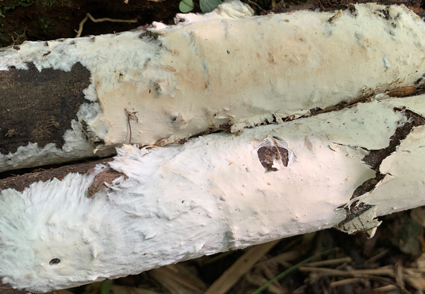Abstract
A new species of Xenasmatella, based on morphology, and molecular analysis (using the nuc rDNA ITS1-5.8S-ITS2 (ITS) dataset), was found growing on the underside of rotten bamboo in Yunnan Province, China. X. roseobubalina is characterized by annual, resupinate basidioma with a pinkish buff hymenophore, a monomitic hyphal system, thin-walled generative hyphae with clamp connections, abundant crystalline matter among the hyphae, the absence of cystidia and cystidioles, and broadly ellipsoid to subglobose basidiospores measuring 3.8–5 × 3.3–4 μm. We present the new species with illustrated description and comparisons to closest species as well as a key to the species of Xenasmatella known from China.
References
<p>Dai, Y.C. (2010) Hymenochaetaceae (Basidiomycota) in China. <em>Fungal Diversity</em> 45: 131–343. https://doi.org/10.1007/s13225-010-0066-9</p>
<p>Dai, Y.C. (2011) A revised checklist of corticioid and hydnoid fungi in China for 2010. <em>Mycoscience</em> 52: 69–79. https://doi.org/10.1007/S10267-010-0068-1</p>
<p>Donk, M.A. (1963) The generic names proposed for Hymenomycetes – XIII. <em>Taxon</em> 12 (4): 153–168. https://doi.org/10.2307/1216184</p>
<p>Duhem, B. (2010) Deux corticiés nouveaux méditerranéens à spores allantoïdes. <em>Cryptogamie Mycologie </em>31: 143–152.</p>
<p>Felsenstein, J. (1985) Confidence intervals on phylogenetics: an approach using bootstrap <em>Evolution</em> 39: 783–791. https://doi.org/10.2307/2408678</p>
<p>Gruhn, G., Gérard, M. & Trichies, G. (2021) Quelques Aphyllophorales non poreìes, rares ou remarquables, observeìes dans le deìpartement de la Mayenne (France). <em>Bulletin de la Société Mycologique de France</em> 137 (1–4): 1–60.</p>
<p>Hall, T.A. (1999) Bioedit: A user-friendly biological sequence alignment editor and analysis program for Windows 95/98/NT. <em>Nucleic Acids Symposium Series</em> 41: 95–98.</p>
<p>Hjortstam, K. & Larsson, K.H. (1987) Additions to <em>Phlebiella</em> (Corticiaceae, Basidiomycetes), with notes on <em>Xenasma</em> and<em> Sistotrema</em>. <em>Mycotaxon</em> 29: 315–319.</p>
<p>Hjortstam, K. & Ryvarden, L. (2005) New taxa and new combinations in tropical corticioid fungi, (Basidiomycotina, Aphyllophorales). <em>Synopsis Fungorum</em> 20: 33–41.</p>
<p>Huang, R.X., Chen, J.Z., Wu, J.R. & Zhao, C.L. (2019)<em> Phlebiella ailaoshanensis</em> <em>sp. nov.</em> (Polyporales, Basidiomycota) described from China. <em>Phytotaxa </em>419 (1): 105–109. https://doi.org/10.11646/phytotaxa.419.1.8</p>
<p>Jeewon, R. & Hyde, K.D. (2016) <em>Establishing species boundaries and new taxa among fungi: recommendations to resolve taxonomic ambiguities</em>. https://doi.org/10.5943/mycosphere/7/11/4</p>
<p>Jülich, W. (1979) Studies in resupinate Basidiomycetes - V. On some new taxa. <em>Persoonia</em> 10 (3): 325–336.</p>
<p>Karsten, P.A. (1890) Fragmenta mycologica XXIX. <em>Hedwigia</em> 29: 147–149.</p>
<p>Katoh, K., Rozewicki, J. & Yamada, K.D. (2019) MAFFT online service: multiple sequence alignment, interactive sequence choice and visualization. <em>Briefings in Bioinformatics</em> 20: 1160–1166. https://doi.org/10.1093/bib/bbx108</p>
<p>Larsson, K.H. (2007) Re-thinking the classification of corticioid fungi. <em>Mycological Research</em> 111: 1040–1063. https://doi.org/10.1016/j.mycres.2007.08.001</p>
<p>Larsson, K.H., Larsson, E., Ryvarden, L. & Spirin, V. (2020) Some new combinations of corticioid fungi (Basidiomycota. Agaricomycetes). <em>Synopsis Fungorum</em> 40: 113–117</p>
<p>Li, H.J., Cui, B.K. & Dai, Y.C. (2014) Taxonomy and multi-gene phylogeny of <em>Datronia</em> (Polyporales, Basidiomycota).<em> Persoonia</em> 32: 170–182. https://doi.org/10.3767/003158514X681828</p>
<p>Liu, Z.B. & Dai, Y.C. (2021) <em>Steccherinum fragile sp. nov.</em> and <em>S. subcollabens comb. nov. </em>(Steccherinaceae, Polyporales), evidenced by morphological characters and phylogenetic analysis. <em>Phytotaxa</em> 483 (2): 106–116. https://doi.org/10.11646/phytotaxa.483.2.3</p>
<p>Maddison, W.P. & Maddison, D.R. (2021) Mesquite: A modular system for evolutionary analysis. Version 3.70. Available from: https://www.mesquiteproject.org/ (accessed March 2022)</p>
<p>Maekawa, N. (2021) Taxonomy of corticioid fungi in Japan: Present status and future prospects. <em>Mycoscience</em> 62 (6): 345–355. https://doi.org/10.47371/mycosci.2021.10.002</p>
<p>Martin, G.W. (1948) New of noteworthy tropical fungi. IV. <em>Lloydia</em> 11 (2): 111–122.</p>
<p>Miller, M.A., Holder, M.T., Vos, R., Midford, P.E., Liebowitz, T., Chan, L., Hoover, P. & Warnow, T. (2009) The CIPRES Portals. CIPRES. Available from: http://www.phylo.org/sub_sections/portal (accessed 4 August 2009) (Archived by WebCite® at: http://www.webcitation.org/5 imQlJeQa)122.</p>
<p>Nees von Esenbeck, C.D.G. (1817) <em>System der Pilze und Schwämme</em>. pp. 1–334.</p>
<p>Nylander, J.A.A. (2004) <em>MrModeltest</em> v2. Program distributed by the author. Evolutionary Biology Centre, Uppsala University.</p>
<p>Oberwinkler, F. (1966) Primitive Basidiomyceten. Revision einiger Formenkreise von Basidienpilzen mit plastischer Basidie. <em>Sydowia</em> 19: 1–72.</p>
<p>Petersen, J.H. (1996) <em>The Danish Mycological Society´s colour-chart</em>. Foreningen til Svampekundskabens Fremme, Greve, pp. 1–6.</p>
<p>Piątek, M. (2005) A note on the genus <em>Xenasmatella</em> (Fungi, Basidiomycetes). <em>Polish</em> <em>Botanical Journal</em> 50 (1): 11–13.</p>
<p>Posada, D. & Crandall, K.A. (1998) Modeltest: testing the model of DNA substitution. <em>Bioinformatics</em> 14: 817–818. https://doi.org/10.1093/bioinformatics/14.9.817</p>
<p>Rambaut, A. (2018) Molecular Evolution, Phylogenetics and Epidemiology. FigTree ver. 1.4.4 Software. Available from: http://tree.bio.ed.ac.uk/software/figtree/ (accessed March 2022)</p>
<p>Ronquist, F. & Huelsenbeck, J.P. (2003) Mrbayes 3: Bayesian phylogenetic inference under mixed models. <em>Bioinformatics</em> 19: 1572–1574. https://doi.org/10.1093/bioinformatics/btg180</p>
<p>Stalpers, J.A. (1996) The aphyllophoraceous fungi II. Keys to the species of the Hericiales. <em>Studies in Mycology</em> 40: 1–185.</p>
<p>Stamatakis, A. (2014) RAxML Version 8: a tool for phylogenetic analyses and post analyses of large phylogenies. <em>Bioinformatics</em> 30: 1312–1313. https://doi.org/10.1093/bioinformatics/btu033</p>
<p>Swofford, D.L. (2002) PAUP*: Phylogenetic analysis using parsimony (*and other methods). Version 4.0b10. Sinauer Associates, Massachusetts.</p>
<p>Thiers, B. (2018) <em>Index Herbariorum: A global directory of public herbaria and associated staff</em>. New York Botanical Garden's Virtual Herbarium, New York. [http://sweetgum.nybg.org/science/ih/]</p>
<p>White, T.J, Bruns, T., Lee, S. & Taylor, J. (1990) Amplification and direct sequencing of fungal ribosomal RNA genes for phylogenetics. <em>In</em>: Innis, M.A., Gelfand, D.H., Sninsky, J.J. & White, T.J. (Eds.) <em>PCR protocols, a guide to methods and applications</em>. Academic Press, New York, pp. 315–322. https://doi.org/10.1038/srep34568</p>
<p>Zhao, C.L., Cui, B.K., Song, J. & Dai, Y.C. (2015) Fragiliporiaceae, a new family of Polyporales (Basidiomycota). <em>Fungal Diversity</em> 70: 115–126. https://doi.org/10.1007/s13225-014-0299-0</p>
<p>Zong, T.K., Wu, J.R. & Zhao, C.L. (2021) Three new <em>Xenasmatella</em> (Polyporales, Basidiomycota) species from China. <em>Phytotaxa</em> 489 (2): 111–120. https://doi.org/10.11646/phytotaxa.489.2.1</p>
<p>Zong, T.K. & Zhao, C.L. (2021) Morphological and molecular identification of two new species of <em>Phlebiella</em> (Polyporales, Basidiomycota) from southern China. <em>Nova Hedwigia</em> 112 (3–4): 501–514. https://doi.org/10.1127/nova_hedwigia/2021/0628</p>


